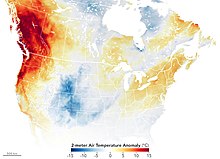
This page documents notable heat waves worldwide in 2021.
Contents
In June 2021, a heat wave set a record high nationwide temperature in Canada. The event led to thousands of heat-related deaths.

This page documents notable heat waves worldwide in 2021.
In June 2021, a heat wave set a record high nationwide temperature in Canada. The event led to thousands of heat-related deaths.
Across Europe [1] and parts of Asia, unusually high-temperatures in the late-winter period were reported from 20 February until 28 February 2021.

Parts of Russia and eastern Europe were hit by record-breaking heat wave in June and July, with temperatures in the Arctic Circle above 30 °C (86 °F) and highest June temperature were recorded in Moscow and St. Petersburg. Temperature 20 °C (36 °F) above average hit central and eastern Europe, with the highest anomalies centered on Scandinavia and parts of western Russia, due to the heat dome effect. [2] Anticyclone conditions over Russia resemble those in the 2010 heat waves, with parts of Siberia were 15 °C (27 °F) higher than normal. [3] The shores of the Barents Sea saw hotter temperatures than beaches in Italy and southern France, around 25–30 °C (77–86 °F) for several days. [4]
In June 2021, Kazakhstan faced a record-breaking increase in temperatures in western parts of the country, specifically the Kyzylorda, Mangystau, and Turkistan regions. As a result, the Kazakh meteorological service Kazhydromet forecasted that an extreme drought would take place. [5] By 7 July, the temperatures reached up to 46.5 °C (115.7 °F). [6] Prior to the announcement of increased temperatures, photos from the Mangystau Region emerged on social media which showed emaciated horses on a verge of dying. [7] According to the Ministry of Agriculture, the cause for situation was due to lack of pasturage in the area as a result of several climatic conditions, and that measures would be implemented to prevent the further casualties of livestock. [8] The Khabar Agency on 16 June 2021 reported that approximately 2,000 livestock had died with Kazakh lawmakers calling for a state of emergency to be implemented in the Mangystau and Kyzylorda regions, citing the problems in farmers whom were unwilling to feed the cattle due to inflated costs for animal feed. [9] [10] In July 2021, due to worsening situation, Kazakh President Kassym-Jomart Tokayev called on Agriculture Minister Saparhan Omarov to resign, citing his failure to provide assistance to struggling farmers. [11] On 13 July, a state of emergency was introduced in the Aral District in an attempt to solve the shortage of feed. [12] In a visit to Mangystau Region, Acting Agriculture Minister Erbol Qaraşukeev pledged that 1.9 billion ₸ would allocated in order to reduce the costs of livestock feed and that a ban on its exports would be placed as well. [13]
An extreme heat wave affected much of Western North America from late June through mid-July 2021. [14] Rapid attribution analysis found this was a 1000-year weather event, made 150 times more likely by climate change. [15] [16] The heat wave affected Northern California, Idaho, Western Nevada, Oregon, and Washington in the United States, as well as British Columbia, and, in its latter phase, Alberta, Manitoba, the Northwest Territories, Saskatchewan, and Yukon, all in Canada. [17] The heat wave appeared due to an exceptionally strong ridge centered over the area, whose strength was linked to the effects of climate change. [18] [19] It resulted in some of the highest temperatures ever recorded in the region, [20] including the highest temperature ever measured in Canada at 49.6 °C (121.3 °F). [21] The exact death toll is unknown, and growing. On July 6, preliminary statistics released by the British Columbia Coroner Service indicated 610 more sudden deaths than usual occurred in the province and Alberta logged 66 excess deaths in the week of the heat wave; [22] [23] the Chief Coroner of British Columbia later said that in the week between June 25 to July 1, 569 deaths were confirmed to have happened due to heat-related causes. [24] Confirmed deaths in the United States include at least 116 in Oregon (of which 72 are in Multnomah County, which includes Portland), [25] [26] [27] at least 112 in Washington [28] and one death in Idaho; [29] though an analysis by The New York Times suggests that around 600 excess deaths occurred on the week the heat wave passed through Washington and Oregon. [30]
In July, a heat wave in Europe led to record-breaking temperatures in the UK and Ireland.
A heat wave impacted North America in August 2021. [31] [32] The heat wave was the second of the summer for the Pacific Northwest. [33] [34] A state of emergency was declared in Oregon. [35] The National Weather Service issued excessive heat warnings for the Portland metropolitan area (including Vancouver, Washington), most of the Columbia River Gorge, and the Willamette Valley. [36] Cooling centers were opened in Portland. [37] Oregon's climatologist said the heat wave is "an indicator of a troubling trend". [38]

A heat wave, or heatwave, or extreme heat, is a period of abnormally hot weather. It is often accompanied by high humidity, especially in oceanic climate countries. While definitions vary, a heat wave is usually measured relative to the usual climate in the area and relative to normal temperatures for the season. Temperatures that people from a hotter climate consider normal can be called a heat wave in a cooler area if they are outside the normal climate pattern for that area. Heatwaves have become more frequent, and over land more intense, almost everywhere since the 1950s, due to climate change.

The 2003 European heat wave saw the hottest summer recorded in Europe since at least 1540. France was hit especially hard. The heat wave led to health crises in several countries and combined with drought to create a crop shortfall in parts of Southern Europe. The death toll has been estimated at more than 70,000.

The 2010 Northern Hemisphere summer heat waves included severe heat waves that impacted most of the United States, Kazakhstan, Mongolia, China, Hong Kong, North Africa and the European continent as a whole, along with parts of Canada, Russia, Indochina, South Korea and Japan during May, June, July, and August 2010. The first phase of the global heatwaves was caused by a moderate El Niño event, which lasted from June 2009 to May 2010. The first phase lasted only from April 2010 to June 2010, and caused only moderate above average temperatures in the areas affected. But it also set new record high temperatures for most of the area affected, in the Northern Hemisphere. The second phase was caused by a very strong La Niña event, which lasted from June 2010 to June 2011. According to meteorologists, the 2010–11 La Niña event was one of the strongest La Niña events ever observed. That same La Niña event also had devastating effects in the Eastern states of Australia. The second phase lasted from June 2010 to October 2010, caused severe heat waves, and multiple record-breaking temperatures. The heatwaves began in April 2010, when strong anticyclones began to develop, over most of the affected regions, in the Northern Hemisphere. The heatwaves ended in October 2010, when the powerful anticyclones over most of the affected areas dissipated.

The 2013 extreme weather events included several all-time temperature records in Northern and Southern Hemisphere. The February extent of snow cover in Eurasia and North America was above average, while the extent of Arctic ice in the same month was 4.5% below the 1981–2010 average. The Northern Hemisphere weather extremes have been linked to the melting of Arctic sea ice, which alters atmospheric circulation in a way that leads to more snow and ice.

Aktau is a city in Kazakhstan, located on the eastern shore of the Caspian Sea. Its current name means 'white mountain' in Kazakh, which may be due to its cliffs that overlook the Caspian. From 1964 to 1991, the city was known as Shevchenko. Its former name was given due to the eponymous Ukrainian poet's period of exile in the area. It is located on the Mangyshlak Peninsula and is the capital of the Mangystau Region.
In May 2015, India was struck by a severe heat wave. As of 3 June 2015, it caused the deaths of at least 2,500 people in multiple regions. The heat wave occurred during the Indian dry season, which typically lasts from March to July with peak temperatures in April and May. Although it typically remains hot until late October, Indian monsoons often provide some respite from the heat.
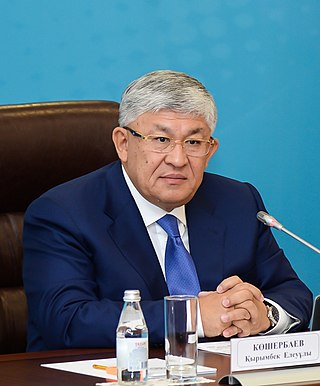
Krymbek Eleuuly Kusherbayev is a Kazakh politician who's serving as the State Secretary of Kazakhstan since 2019. Prior to that, Kusherbayev served as the head of the Presidential Administration, akim of Kyzylorda Region from 2013 to 2019, First Deputy Prime Minister of Kazakhstan from 2012 to 2013, akim of Mangystau Region from 2006 to 2011, Ambassador of Kazakhstan to Russia, Finland and Armenia from 2003 to 2006, akim of West Kazakhstan Region from 2000 to 2003, and the Minister of Education and Science from 1997 to 2000.

The 2018 Britain and Ireland heat wave was a period of unusually hot weather that took place in June, July and August. It caused widespread drought, hosepipe bans, crop failures, and a number of wildfires. These wildfires worst affected northern moorland areas around the Greater Manchester region, the largest was at Saddleworth Moor and another was at Winter Hill, together these burned over 14 square miles (36 km2) of land over a period of nearly a month.
The 2018 North American heat wave affected regions of Canada, where at least 70 deaths in Quebec were heat-related, the United States, where 18 states between Michigan and New Mexico issued heat advisories to a population of over 60 million people, and of Mexico, particularly the northwest and central regions.
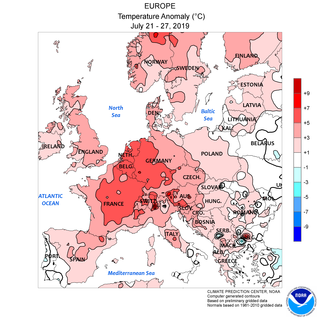
In late June and late July 2019 there were two temporally distinct European heat waves, which set all-time high temperature records in Belgium, France, Germany, Luxembourg, the Netherlands, and the United Kingdom.
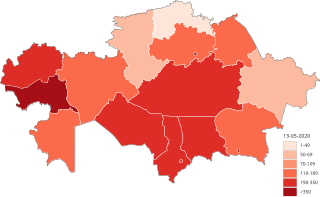
The COVID-19 pandemic in Kazakhstan was a part of the worldwide pandemic of coronavirus disease 2019 caused by severe acute respiratory syndrome coronavirus 2. The virus was confirmed to have reached Kazakhstan on 13 March 2020 after two Kazakh citizens in Almaty returned from Germany. That same day, two more cases were confirmed, with one female arriving from Italy in Astana and the other from Germany in Almaty as well. Following the outbreak, on 15 March 2020, President Kassym-Jomart Tokayev declared a state of emergency that was set to last until 15 April 2020. However, measures were prolonged in order to curb the transmission of the virus, leading to many notable holidays such as Nowruz and the Victory Day being cancelled. On 19 March 2020, a strict quarantine was placed on the cities of Astana and Almaty, where the most cases were occurring. On 30 March 2020, Atyrau and five cities in Karaganda Region went under a lockdown.

Saparhan Kesıkbaiūly Omarov is a Kazakh politician who served as the Minister of Agriculture from 2019 to 2021. Prior to that, he served as the member of the Mazhilis from 2016 to 2019 and Vice Minister of Agriculture from 2014 to 2016.

The 2021 Western North America heat wave was an extreme heat wave that affected much of Western North America from late June through mid-July 2021. Extreme event attribution found this was a 1000-year weather event, made 150 times more likely by climate change. A study in Nature Climate Change estimated that its occurrence, while previously thought virtually impossible, has become an event that may occur every 200 years under current climate warming. The heat wave affected Northern California, Idaho, Western Nevada, Oregon, and Washington in the United States, as well as British Columbia, and in its latter phase, Alberta, Manitoba, the Northwest Territories, Saskatchewan, and Yukon, all in Canada. It also affected inland regions of Central and Southern California, Northwestern and Southern Nevada and parts of Montana, though the temperature anomalies were not as extreme as in the regions farther north.
In Central Asia, a drought began in around April 2021, which affected most of Central Asia and parts of Russia. As a result, this led to mass livestock death, most notably in horses, and water shortages for irrigation. Food prices in the areas have been reported to increase following the drought. The shortages and drought have been linked to climate change.

This page documents notable heat waves worldwide in 2022. Many heat waves were worsened by climate change and its effects. Notably, heat waves across Europe, which also affected the United Kingdom, started in June and continued throughout July into August. They caused continent-wide wildfires, with thousands dying due to heat-related causes. Other heat waves have been felt throughout the year, including in the Americas, China, Australia and the Indian subcontinent.

The 2022 Japan heatwave was a heatwave that affected many prefectures. Temperatures peaked at 40.2 °C (104.4 °F) in Isesaki, Gunma Prefecture. 15,657 people were taken to hospital emergency departments, 5,261 of whom were admitted.
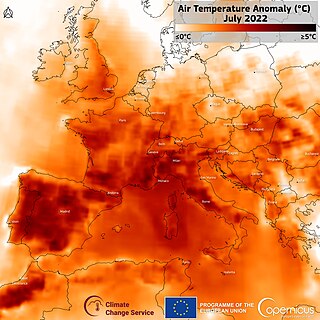
From June to August 2022, persistent heatwaves affected parts of Europe, causing evacuations and over 20,000 heat-related deaths, making these heat waves the deadliest meteorological events in 2022. The highest temperature recorded was 47.0 °C (116.6 °F) in Pinhão, Portugal, on 14 July.
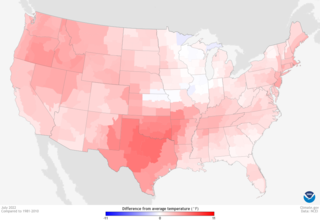
From late spring to late summer heat waves in 2022 smashed many records in North America between May and September of that year. Dozens of temperature records were surpassed in the United States.
Starting in May 2023, a heat wave has affected Western North America.